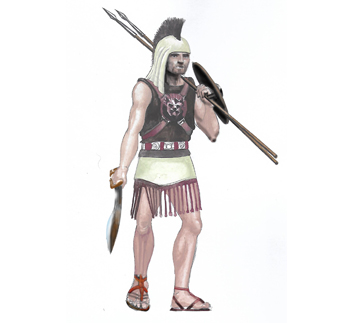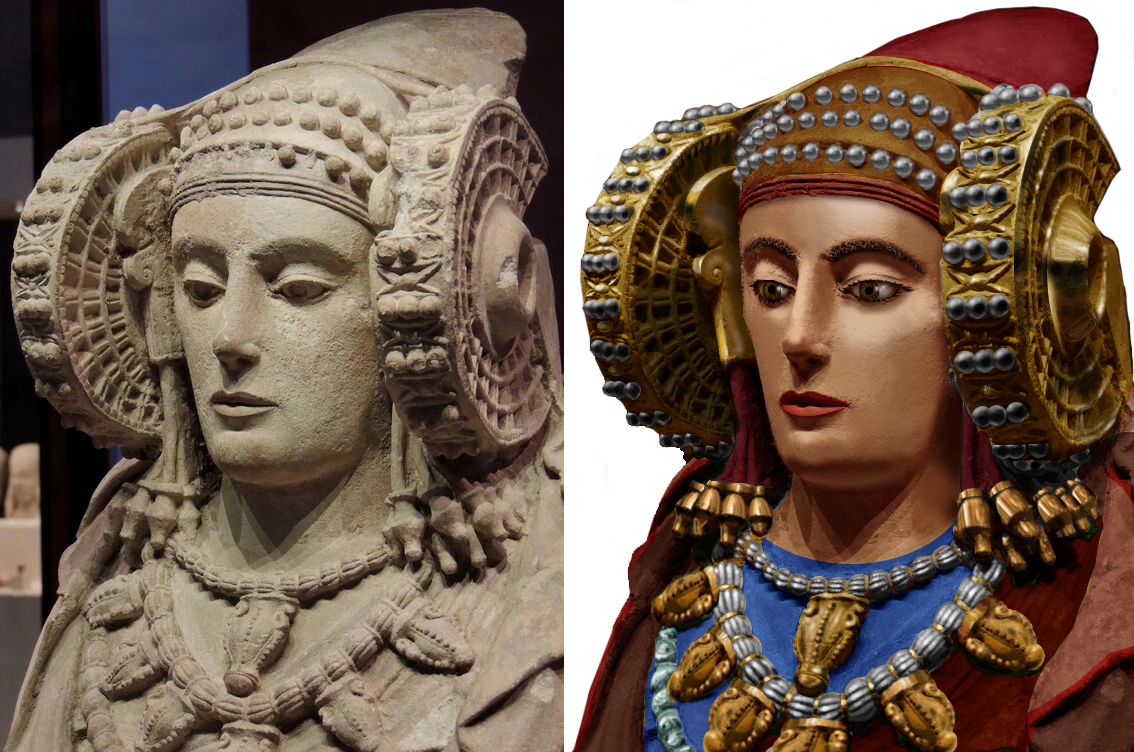
About Ancient Iberia
The Caetrati was an Iberian caetra bearer, a kind or relatively small round shield.But the caetrati also belongs to a whole mozaik of cultures, called "the Iberians". There is a whole chapter to be made on the various peoples that inhabited the peninsula stretched between the Pyrenees and Hercules columns, the gateway to the Atlantic or at that time, the "external sea".
In terms of diversity, the same could be said of Italy, less so for Gaul. Populations diversity was indeed considerable: In short, by around 300 BC, the southern part was held by Phoenician-origin peoples like the Turdetanians (the Tartessanian culture), to the west coast by Iberians like the Bastetani and Edetani, Ilercavones and Ilergetes, Greek influenced Iberian peoples like the Indiketes centered around Emporio (Empurias today), north Aquitanian peoples like the Vascones, ad the whole central and eastern part of the peninsula under Celtic influence.
From the latest arrived, the Celtiberians, to the Vascones, Cantabri, Carpetani, Turduli, and Celts of a more ancient stock on the Western coast, the Lusitanians and Vettones in particular and the Callaeci, ancestors of the Galicians which culture is supposed to have "landed" in Ireland also, at that time called Goidel. They all had in common the use of oblong or rectangular shields (Scuta) and round shield (Caetra). We will focus on the latter in this.

Iberian Map
The Iberians left arguably more scripts, bas-reliefs, graffiti and vases paintings than the northern Celts to get a visual picture of what they looked like (see the examples below). In general these wore tunics, some with fringes, and various armor kits, among which the famous round bronze disc strapped on the thorax, that was the most distinctive pierce of armor of Iberian warriors as a whole, outside the scale armor apparently widely used.
Wether it was made of bronze scales of leather, it's still matter of interpretation of the vase painting, and therefore, of debate. No remnants of a bronze scale armor was never ever found in Spain. A few helmets were discovered, among which the most famous was the Celtiberian helmet of chalcidian type, found in the province of Zaragoza and featuring deep cheek-guards and a vertical fork to fix a horsehair crest. The standard bowl shaped model, probably in leather, and the flexible horsehair leather cap, flowing on the shoulders with many folds are favourite items to describe Iberian helmets, frequently associated with the falcata, pectoral disc, and caetra, whereas Celtiberian warriors usually had pantashorts, a Montefortino plumed helmet, chainmail, and straight Celtic longsword, plus the larger Scutum.
The differentiation between both kind of shields was made in Latin, at a time wars between the Romans and Iberian Nations after 206 BC, up to 197 BC when the provinces of Hispania Citerior and ulterior were created, in the southern and western fringes of the peninsula. From that date, the campaign of Marcus Portius Cato (the Elder) started, ad Iberian resistance lasted until 182 BC.

The "Lady of Elche", the most amazing female sculpture in Iberia (Reconstruction by the Author). She was very closed to the Lady of Guardamar, discovered in 1987 while the Lady of Baza was a full seated sculpture with refined incrustations which survived until today, attributed to the Bastetani. The Lady of Cerro de los Santos had more pronounced Phoenician features
From then on a new era began, the first Celtiberian War (181–179 BC) in which the Lusitanian made an stand through Thurru. The Second Celtiberian War started in 155 BC and from there, appeared a Lusitanian folk hero, Viriatho, very much in par with Arminius for the Germans or Vercingetorix for the French today. The man was so bold, reckless and successful in guerilla warfare that the Romans named from 147 BC onwards this conflict as the "Viriathic War". Abd from 143 BC started the the Numantine War (after Numancia and the last bastion of the Celtiberians), just like Alesia for the Gauls.
Afterwards, conflict emerged once again sporadically as some tribes surged to war or rebelled, and 82 BC most of the Celtiberians rose at war again. There was also a conflict between Vascones and Celtiberians, and the Roman civil war led in Iberia to the Sertorian War, after Quintus Sertorius allied with local tribes, that rebelled against Silla and was eventually beaten by Pompey and Caecilius Metellus.
Sources/Read More
TW Center.net The Iberians Compiled InformationsWeapons & Warfare Iberian Cavalry
www4.uwm.edu Celts in Iberia
Lusitanian/Galician caetrati
♕ Aquitani & Vasci ♕ Celts ♕ Indo-greeks ♕ Veneti ♕ Yuezhi ♕ Indians ♕ Etruscans ♕ Numidians ♕ Samnites ♕ Judaean ♕ Ancient Chinese ♕ Corsico-Sardinians
⚔ Cingetos ⚔ Immortals ⚔ Cavaros ⚔ Cataphract ⚔ Romphaiorioi ⚔ Chalkaspidai ⚔ Devotio Warrior ⚔ Scythian Horse archer ⚔ The Ambactos ⚔ Iberian warfare ⚔ Illyrian warriors ⚔ Germanic spearmen ⚔ Carthaginian Hoplite ⚔ Thracian Peltast ⚔ Caetrati ⚔ Ensiferi ⚔ Hippakontistai ⚔ Hastati ⚔ Gaesatae ⚔ Cretan Archer ⚔ Thorakitai ⚔ Soldurii ⚔ Iphikrates ⚔ Kardaka ⚔ The thureophoroi